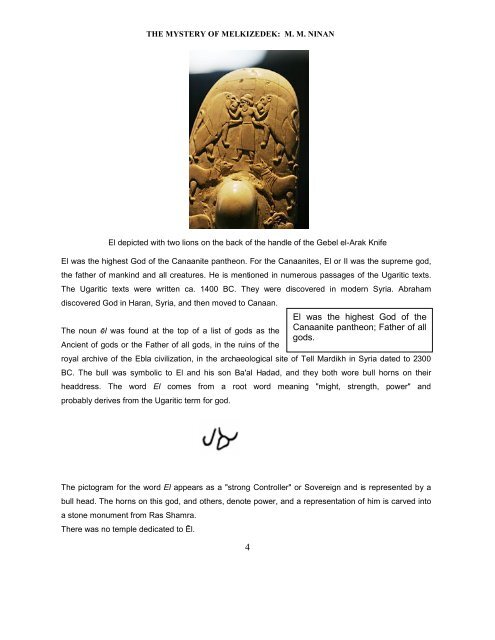Mystery of Melchzedek
Create successful ePaper yourself
Turn your PDF publications into a flip-book with our unique Google optimized e-Paper software.
THE MYSTERY OF MELKIZEDEK: M. M. NINAN<br />
El depicted with two lions on the back <strong>of</strong> the handle <strong>of</strong> the Gebel el-Arak Knife<br />
El was the highest God <strong>of</strong> the Canaanite pantheon. For the Canaanites, El or Il was the supreme god,<br />
the father <strong>of</strong> mankind and all creatures. He is mentioned in numerous passages <strong>of</strong> the Ugaritic texts.<br />
The Ugaritic texts were written ca. 1400 BC. They were discovered in modern Syria. Abraham<br />
discovered God in Haran, Syria, and then moved to Canaan.<br />
The noun ēl was found at the top <strong>of</strong> a list <strong>of</strong> gods as the<br />
Ancient <strong>of</strong> gods or the Father <strong>of</strong> all gods, in the ruins <strong>of</strong> the<br />
royal archive <strong>of</strong> the Ebla civilization, in the archaeological site <strong>of</strong> Tell Mardikh in Syria dated to 2300<br />
BC. The bull was symbolic to El and his son Ba'al Hadad, and they both wore bull horns on their<br />
headdress. The word El comes from a root word meaning "might, strength, power" and<br />
probably derives from the Ugaritic term for god.<br />
El was the highest God <strong>of</strong> the<br />
Canaanite pantheon; Father <strong>of</strong> all<br />
gods.<br />
The pictogram for the word El appears as a "strong Controller" or Sovereign and is represented by a<br />
bull head. The horns on this god, and others, denote power, and a representation <strong>of</strong> him is carved into<br />
a stone monument from Ras Shamra.<br />
There was no temple dedicated to Ēl.<br />
4


















